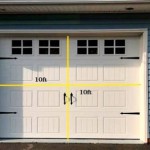Painting a Metal Garage Door to Mimic the Look of Wood
Metal garage doors offer durability and security, but they often lack the aesthetic appeal of natural wood. However, through a careful painting process, it is possible to transform a standard metal garage door into a convincing replica of a wooden one. This transformation involves selecting the right paints, applying a base coat and faux wood grain, and adding protective layers to ensure longevity and weather resistance. The following article outlines the steps involved in achieving this visual transformation.
Preparation and Material Selection
The initial phase of this project is crucial. Success depends on meticulous preparation and selecting the appropriate materials. Proper preparation ensures the paint adheres correctly and the faux wood grain finish looks realistic and lasts for years to come.
The first step is cleaning the metal garage door. This process removes any dirt, grime, rust, or existing paint that could interfere with the new paint’s adhesion. Using a pressure washer or a stiff-bristled brush along with a detergent formulated for metal surfaces is recommended. After washing, the door must be thoroughly rinsed and allowed to dry completely. Any signs of rust should be removed with a wire brush or sandpaper. For extensive rust, a rust converter can permanently neutralise the rust.
Masking is also vital. Use painter's tape to protect the surrounding areas, such as the trim, siding, and driveway, from accidental paint splatters. Cover any hardware, like handles or hinges, that should not be painted. Applying masking tape carefully ensures clean lines and a professional-looking finish.
Selecting the right primer is critical for proper adhesion. A high-quality bonding primer specifically designed for metal is essential. The primer acts as a bridge between the metal surface and the topcoat, promoting adhesion and preventing rust formation. Two coats of primer may be necessary, depending on the condition of the existing surface.
Choosing the right paint colors is paramount for achieving a realistic wood grain effect. Select two or three shades of brown that mimic the natural variations found in wood. Consider using a darker base coat to represent the deeper grain and lighter shades for the highlights. Acrylic latex paints are generally recommended for exterior use due to their durability and resistance to fading. Ensure the paint is suitable for metal surfaces and exterior applications.
Finally, gather the necessary tools. A variety of paint brushes, including a wide brush for the base coat and a narrower brush for the wood grain details, is necessary. A wood graining tool, which can be purchased at most paint or hardware stores, is essential for creating the wood grain pattern. Other tools include paint rollers, paint trays, rags, stir sticks, and safety glasses.
Application Techniques for a Realistic Wood Grain
The application of the base coat and the subsequent wood grain technique is where the metal garage door begins its transformation into a wood-look structure. Patience and attention to detail are critical in this phase to achieve a realistic and visually appealing finish.
Begin with the application of the primer. Apply the primer evenly using a brush or roller, ensuring complete coverage of the metal surface. Allow the primer to dry completely according to the manufacturer’s instructions. Once the primer is dry, apply the base coat of paint. This coat serves as the foundation for the wood grain. Applying a thin, even coat is recommended, avoiding drips or runs. Allow the base coat to dry completely before proceeding.
The wood grain technique is the key step in creating the illusion of wood. Apply a thin layer of the lighter shade of paint over a section of the base coat. While the paint is still wet, use the wood graining tool to create the wood grain pattern. Rock the tool back and forth along the surface in long, continuous strokes. Experiment with different pressures and angles to create varying patterns.
Wipe off the excess paint from the wood graining tool with a clean rag after each stroke. This prevents the tool from becoming clogged with paint and ensures a clean, defined wood grain pattern. Work in small sections to prevent the paint from drying before the wood grain effect can be created. If the paint dries too quickly, reapply a thin layer of paint before using the wood graining tool.
Vary the pattern and direction of the wood grain to mimic the natural inconsistencies found in real wood. Consider adding knots or other wood-like features to enhance the realism. A small brush can be used to create these details. Allow the paint to dry completely after completing the wood grain application. Applying additional layers of paint and wood graining, using slightly different shades, can further enhance the depth and realism of the finish.
Protection and Maintenance
After completing the painting and wood graining, protecting the finish is essential for longevity and maintaining the desired aesthetic. A clear topcoat provides a protective barrier against the elements and helps to prevent fading, chipping, and scratching. Regular maintenance will also help to keep the garage door looking its best.
Apply a clear, UV-resistant topcoat to protect the painted surface. This topcoat will shield the paint from the sun's harmful rays, preventing fading and discoloration. Applying two or three coats of topcoat is generally recommended for optimal protection. Ensure each coat dries completely before applying the next.
Regular cleaning is crucial for maintaining the appearance of the garage door. Wash the door periodically with a mild detergent and water to remove dirt, grime, and other debris. Avoid using harsh chemicals or abrasive cleaners, as these can damage the paint finish. A soft-bristled brush or sponge can be used to gently scrub the surface.
Inspect the garage door regularly for any signs of damage, such as scratches, chips, or peeling paint. Touch up any damaged areas promptly to prevent further deterioration. A small amount of paint and a fine-tipped brush can be used to repair minor imperfections. For larger areas of damage, it may be necessary to repaint the entire section.
Lubricating the moving parts of the garage door, such as the hinges and rollers, is also important for maintaining its functionality and preventing premature wear. Use a silicone-based lubricant specifically designed for garage doors.
Consider applying a fresh coat of topcoat every few years to maintain the protective barrier and keep the paint looking its best. This will help to extend the life of the paint finish and prevent the need for more extensive repairs in the future. With proper care and maintenance, a metal garage door painted to look like wood can provide years of aesthetic appeal and functional performance.

Faux Wood Garage Door Tutorial Prodigal Pieces

Old Metal Garage Door Transformation Faux Wood Finish Detailed Diy Instructions

Create A Faux Wood Garage Door With Gel Stain Crazy Life Littles

The Step By Guide To Painting Your Garage Door Look Like Stained Wood In My Own Style

Create A Faux Wood Garage Door With Gel Stain Crazy Life Littles

Create A Faux Wood Garage Door With Gel Stain Crazy Life Littles

Faux Wood Garage Door Tutorial Prodigal Pieces

Faux Wood Garage Door Tutorial Prodigal Pieces

Create A Faux Wood Garage Door With Gel Stain Crazy Life Littles

Diy Garage Door Makeover With Gel Stain Fresh Mommy Blog
Related Posts








